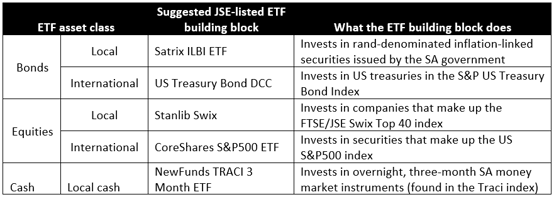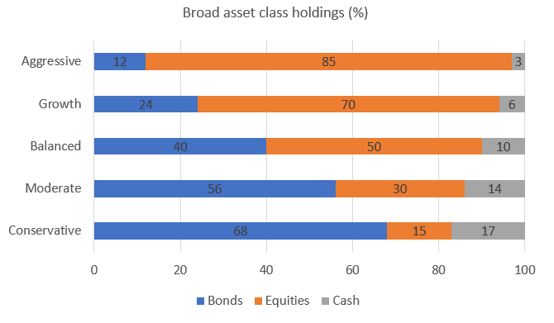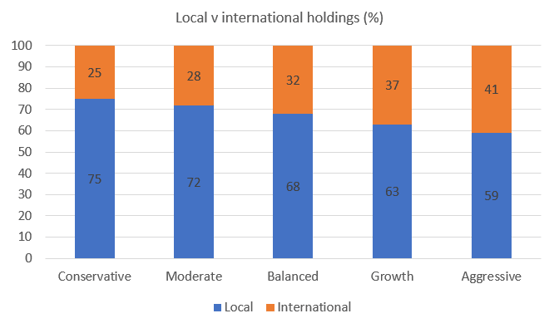Intellidex Reviews: Using ETFs to allocate your portfolio across assets
ETFs are not just a useful investment on their own. They are also good instruments to use to build a diverse investment portfolio. In our research notes on different ETFs for EasyEquities we have often highlighted that they can be used as building blocks for a core investment portfolio or to supplement your existing one.

This week we look at how to build an investment portfolio from scratch by carefully combining different ETF asset classes to suit one’s risk-return profile. Our thoughts here are meant to be illustrative only: we recommend that investors seek advice from their financial advisors on how to build a portfolio that suits their individual needs.
We demonstrate below how ETFs can be used as building blocks to construct unique investment portfolios based on five investor archetypes that BlackRock uses – the biggest fund manager in the world by assets under management. BlackRock developed these archetypes for the Australian market and we transpose the concept onto the SA scenario, making minor tweaks to suit the local context. In the following weeks, we will look at other specialised ETF strategies aimed at specific tactical (short- to medium-term) risk-return objectives.
It is important for investors to get the asset class balance right in their portfolios. Research into US pension funds by Gary Brinson, Randolph Hood and Gilbert Beebower – known collectively as BHB – in 1991 confirmed that more than 91,5% of a portfolio’s return is attributable to its mix of asset classes. In this study, individual stock selection and market timing accounted for less than 7% of a diversified portfolio’s returns. Since then, other research has confirmed the principles of this assertion. That highlights just how important asset allocation is rather than stock picking.
Once you have your asset class mix right, you can tweak your core portfolio using other specialised strategies in your quest to outperform the market.
In developing our model portfolio for each archetype, we discuss ways to blend favoured ETFs that we’ve been analysing weekly for EasyEquities with typical investor archetypes. The main difference in the portfolios of different investor archetypes is the weight of different asset classes. The process of assigning weights of asset classes in a portfolio is called asset allocation, and the main asset classes are:
- Equities: Shares in companies or funds that hold shares in companies
- Bonds: Instruments that represent the debts of companies or government entities that pay a fixed rate of interest. Retail investors usually access these by investing in funds that invest in bonds.
- Cash: Deposits that earn a variable interest rate or funds that invest in the money market.
- Other asset classes such as property and commodities.
We focus on the main three classes – equities, bonds and cash – as the other classes have features that are similar to these.
Equities are riskier than bonds. In equities, there is a chance of losing your money. In bonds, however, the return you will earn on the principal investment is known up front – to a point. Bond prices move as interest rates move (in opposite directions), so there is still some risk. There is also still some risk of default, although that is rare, especially when you are invested in government bonds, which are deemed to be the safest of investments. Cash funds have much less interest rate risk, so the value of your investment is assured, though the return you earn varies with interest rates.
During portfolio construction, bonds and equities are viewed through the prism of local and international exposures.
In deciding on the split between asset classes, the main issue to consider is the time horizon and liquidity. Your age and how much you depend on your investments to cover your day-to-day expenses determine the time horizon of your investment, which then defines your risk tolerance. Generally speaking, a longer time horizon means an investor can tolerate higher variability of asset returns (which is what defines risk in investment terms).
The following five investor archetypes are built on the premise of time horizon and liquidity, and set according to the age of the client:
- Conservative: over 65 years
- Moderate: between 55 and 65 years
- Balanced: between 45 and 55 years
- Growth: between 35 and 45
- Aggressive: under 35
We’ve used our judgment in assigning age ranges for each archetype, but it is really the attitude to risk that matters. That has to be determined for each individual. Below, table 1 shows the suggested asset weights for each investor archetype.
Table 1

In table 2, we propose JSE-listed ETF exposures that give exposure to each asset class:
Table 2

For an easy explanation of all the jargon in the above table, have a look at our previous notes on those specific ETFs.
To get a picture of how important asset allocation is, we simulated returns for each archetype based on annualised five-year returns to end-May 2017 for the ETF building blocks suggested in table 2. In the case of the US Treasury Bond DCC and CoreShares S&P500 ETF, we used their respective indices because they were only launched recently. Table 3 shows the back-tested results, which we feel are encouraging:
Table 3

Table 4 (similar to Table 3, but excludes international bonds)

To incorporate standard deviation and the Sharpe ratio in our calculations we excluded international bonds (and used only local bonds for bonds exposure) as we could not find enough data for international bonds. Comparatively, Table 4 shows inferior returns compared with table 3 which includes international bonds.
A higher Sharpe ratio means the risk-adjusted returns are better. Although volatility (as measured by the standard deviation) is high for more aggressive portfolios, the risk-adjusted return (Sharpe ratio) shows that more aggressive portfolios experienced superior risk-adjusted returns. However, investors should note that these results are based on the five years months to end-May, and expanding the time period might yield a different outcome.
More detail on weightings between asset classes and between local and international exposure is provided in the following graphs:


Background: Exchange-traded funds (ETFs)
Exchange-traded funds (ETFs) are passively managed investment funds that track the performance of a basket of pre-determined assets. They are traded the same way as shares and the main difference is that whereas one share gives exposure to one company, an ETF gives exposure to numerous companies in a single transaction. ETFs can be traded through your broker in the same way as shares, say, on the EasyEquities platform. In addition, they qualify for the tax-free savings account, where both capital and income gains accumulate tax free.
Benefits of ETFs
- Gain instant exposure to various underlying shares or bonds in one transaction
- They diversify risk because a single ETF holds various shares
- They are cost-effective
- They are liquid – it is usually easy to find a buyer or seller and they trade just like shares
- High transparency through daily published index constituents
If you thought this blog was interesting, you should also read:
Intellidex Reviews: Ashburton MidCap ETF
Disclaimer
This research report was issued by Intellidex (Pty) Ltd. Intellidex aims to deliver impartial and objective assessments of securities, companies or other subjects. This document is issued for information purposes only and is not an offer to purchase or sell investments or related financial instruments. Individuals should undertake their own analysis and/or seek professional advice based on their specific needs before purchasing or selling investments. The information contained in this report is based on sources that Intellidex believes to be reliable, but Intellidex makes no representations or warranties regarding the completeness, accuracy or reliability of any information, facts, estimates, forecasts or opinions contained in this document. The information, opinions, estimates, assumptions, target prices and forecasts could change at any time without prior notice. Intellidex is under no obligation to inform any recipient of this document of any such changes. Intellidex, its directors, officers, staff, agents or associates shall have no liability for any loss or damage of any nature arising from the use of this document.
Remuneration
The opinions or recommendations contained in this report represent the true views of the analyst(s) responsible for preparing the report. The analyst’s remuneration is not affected by the opinions or recommendations contained in this report, although his/her remuneration may be affected by the overall quality of their research, feedback from clients and the financial performance of Intellidex (Pty) Ltd.
Intellidex staff may hold positions in financial instruments or derivatives thereof which are discussed in this document. Trades by staff are subject to Intellidex’s code of conduct which can be obtained by emailing mail@intellidex.coza.
Intellidex may also have, or be seeking to have, a consulting or other professional relationship with the companies mentioned in this report.
Subscribe To Our Research Portal
Search all research
Let Us Help You, Help Yourself
From how-to’s to whos-whos you’ll find a bunch of interesting and helpful stuff in our collection of videos. Our knowledge base is jam packed with answers to all the questions you can think of.
